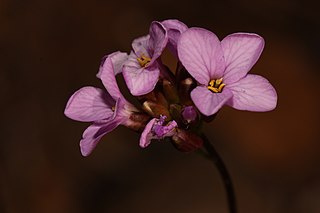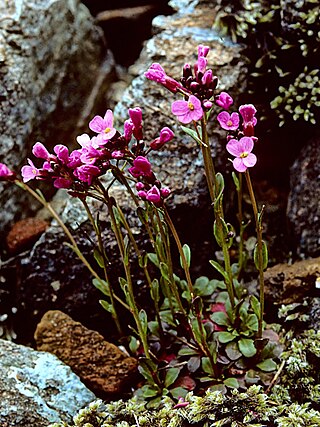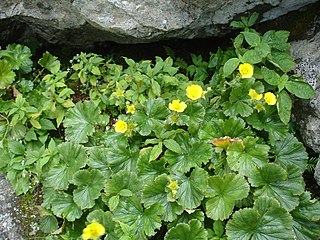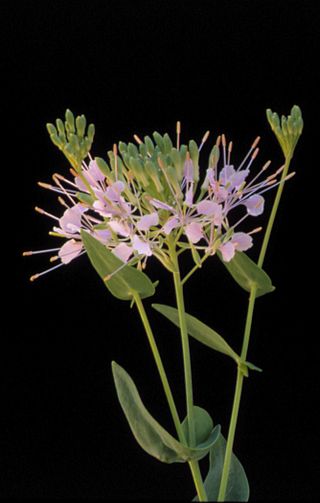
Turritis glabra, commonly known as tower rockcress or tower mustard, is a tall, slim, grey-green plant with small creamy flowers at the top of the stem. It usually grows on poor chalky or sandy soils, in open situations. It is native to Europe, Asia, and North Africa, and it is widespread in North America where it is also probably native. It can be found in many other parts of the world as an introduced species.

Arabis aculeolata is a species of flowering plant in the mustard family known by the common name Waldo rockcress.
Boechera cobrensis is a species of flowering plant in the mustard family known by the common names Masonic rockcress and sagebrush rockcress. It is native to the western United States from eastern California to Wyoming, where it is found in sandy habitat, especially sagebrush. This is a perennial herb growing several erect, slender stems to heights near half a meter from a branching caudex. The plant forms a narrow clump with a base of narrow, linear, densely hairy leaves up to 5 centimeters long. There are also a few slightly shorter leaves clasping the stems at intervals. The top of each stem is occupied by an inflorescence of small, nodding flowers with dull yellowish sepals and white petals. The flowers give way to fruits which are narrow, straight siliques up to 4 centimeters long containing winged seeds.

Boechera hoffmannii is a rare species of flowering plant in the family Brassicaceae known by the common name Hoffmann's rockcress. It is endemic to the Channel Islands of California, where it is known from only three or four populations on two of the eight islands. A 2005 report estimated a remaining global population of 244 individual plants. It is a federally listed endangered species.

Arabis lemmonii is a species of flowering plant in the family Brassicaceae known by the common name Lemmon's rockcress. It is native to western North America from Alaska to California to Colorado, where it grows in a number of rocky habitat types.

Arabis macdonaldiana is a species of flowering plant in the mustard family known by the common name MacDonald's rockcress. It is native to northern California and Oregon, where it grows on newly exposed, barren serpentine soils in openings in temperate coniferous forest habitat. It is a rare and endangered plant known from several sites in California and approximately two occurrences in Oregon, where it is threatened mainly by mining, particularly of nickel, which is one of several metals plentiful in the serpentine. On September 29, 1978, this was the second plant to be federally listed as an endangered species.

Sibara filifolia, the Santa Cruz Island winged rockcress or Santa Cruz Island rockcress, is a rare species of flowering plant in the family Brassicaceae. It is endemic to the Channel Islands of California, where it is now known from a few occurrences on San Clemente Island and one population on Catalina Island.

Thelypodium stenopetalum is a rare species of flowering plant in the mustard family known by the common names slenderpetal thelypody, slender-petaled thelypodium and slender-petaled mustard. It is endemic to the San Bernardino Mountains of southern California, where it is known from only three or four extant occurrences in moist mountain meadows near Big Bear Lake. Its remaining habitat is considered seriously threatened and the plant is a federally listed endangered species in the United States.

Borodinia serotina is a rare species of flowering plant in the mustard family known by the common name shale barren rockcress. It is native to eastern West Virginia and western Virginia in and around the Shenandoah Valley, where it is known from 62 populations. It is endemic to the shale barrens, a type of habitat characterized by steep slopes of bare shale, an exposed, rocky habitat type that is subject to very dry and hot conditions. Shale barrens host a number of endemics, such as Allium oxyphilum and Taenidia montana, and this rockcress is among the rarest. It is a federally listed endangered species.

Clematis socialis is a rare species of flowering plant in the buttercup family known by the common name Alabama leather flower. It is native to the US states of Alabama and Georgia, where it is known from only five populations. The species is seriously threatened by habitat destruction. It is a federally listed endangered species.

Geum radiatum is a rare species of flowering plant in the rose family known by the common names spreading avens, Appalachian avens, and cliff avens. It is native to the region of the border between Tennessee and North Carolina in the southeastern United States, where there are eleven known populations remaining. The plant was federally listed as an endangered species in 1990.
Paysonia perforata, known by the common name Spring Creek bladderpod, is a rare species of flowering plant in the mustard family. It is endemic to Tennessee in the United States, where it is known only from Wilson County. This very rare plant is threatened by the loss and degradation of its habitat. It is federally listed as an endangered species.

Sanicula purpurea is a rare species of flowering plant in the carrot family known by the common names purple-flower black-snakeroot and purple-flowered sanicle. It is endemic to Hawaii, where it is known from Maui and from the Koolau Mountains on the island of Oahu. It is threatened by the degradation of its habitat. It was federally listed as endangered species of the United States in 1996.

Spigelia gentianoides is a rare species of flowering plant in the Loganiaceae known by the common names purpleflower pinkroot and gentian pinkroot. It is native to Alabama and Florida in the United States, where a few small populations remain. It is threatened by the loss and degradation of its habitat, and is a federally listed endangered species of the United States.

Spiranthes delitescens is a rare species of orchid known by the common names reclusive lady's tresses, Canelo Hills lady's tresses, and Madrean lady's tresses. It is native to Arizona in the United States, where there are only four occurrences. It is threatened by the loss and degradation of its habitat. It is a federally listed endangered species of the United States.

Warea amplexifolia is a rare species of flowering plant in the mustard family known by the common names wideleaf pinelandcress, wide-leaf warea, and clasping warea. It is endemic to Florida in the United States, where it is limited to a few counties in the central part of the peninsula. It is threatened by the loss and degradation of its habitat. It is a federally listed endangered species of the United States.

Pennellia tricornuta is a species of flowering plant in the mustard family known by the common names Rincon Mountain rockcress and Chiricahua rockcress. It is endemic to Arizona in the United States, where it occurs in Cochise, Pima, and Santa Cruz Counties.
Boechera fecunda is a species of flowering plant in the mustard family known by the common names Mt. Sapphire rockcress and Sapphire rockcress. It is endemic to Montana in the United States, where there are twenty known occurrences in three counties.

Leavenworthia crassa is a species of flowering plant in the mustard family, Brassicaceae, known commonly as the fleshy-fruit gladecress. It is endemic to Alabama in the United States, where it occurs in only two counties. It is "likely one of the most imperiled plant species in the Southeast," and the United States Fish and Wildlife Service issued a final rule listing it as an endangered species in 2014.

Physaria thamnophila is a rare species of flowering plant in the mustard family known by the common name Zapata bladderpod. It is native to Texas in the United States, where it is known from Zapata and Starr Counties. The plant is threatened by the loss and degradation of its habitat. It is federally listed as an endangered species.


















